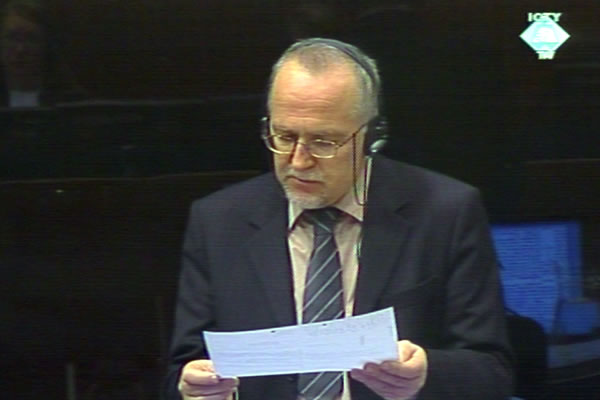Home
PROFESSOR ZECEVIC MOVES FROM DOCK TO WITNESS STAND
Despite the attempts by Karadzic’s defense to challenge the expertise and impartiality of Professor Berko Zecevic, his expert reports on the explosion at the Markale market in February 1994 and on the manufacture and use of the so-called modified air bombs in the siege of Sarajevo were admitted into evidence. Karadzic was granted a total of six hours to cross-examine the prosecution expert
 Berko Zecevic, witness at the Radovan Karadzic trial
Berko Zecevic, witness at the Radovan Karadzic trial Last Friday, Professor Berko Zecevic stood in the dock charged with ‘willful and deliberate obstruction of the administration of justice’ because he had refused to testify at the Radovan Karadzic trial. Today Zecevic moved in the witness stand. Zecevic spent most of his time standing up as he testified, as if he were a teacher giving a lecture to his students. Because of the witness’s medical problems the court was in session for less than 30 minutes instead of the regular 90 minutes, with five-minute breaks in between.
At the beginning, the prosecutor outlined Professor Zecevic’s professional and university career, starting with his work on the projectile and warhead design in the Pretis factory in Sarajevo. The Pretis factory was one of the largest defense industries in the former Yugoslavia. Zecevic continued his career at the Faculty of Mechanical Engineering where today he heads the Defense Technology Department.
Peter Robinson, legal advisor to the accused, today tried to contest Professor Zecevic’s expertise, claiming that Zecevic was not a ballistic expert but an expert on the design of artillery and rocket projectiles. Robinson also challenged the witness’s objectivity arguing that Zecevic was partial because he had worked for the BH Army defense industry in 1992 and 1993. The judges dismissed the objection and allowed the prosecutor to tender into evidence Professor Zecevic’s expert report on the type, caliber and direction of the projectile that caused the first Markale massacre in February 1994.
According to the report, the launch zone of a 120-mm mortar shell is 5,600 to 6,400 meters from the impact site. The shell came in from a north-northeasterly direction and hit the ground at a speed of at least 60 meters per second, about 200 kmh. In his reply to a hypothetical question asked by prosecutor Fergal Gaynor, Professor Zecevic ruled out the possibility that the shell was not fired from a mortar but dropped on the town market from the roof of a neighboring building.According to Zecevic, this was ‘an unrealistic scenario, something that could be done only in science-fiction movies’.
The witness’s expert report on the manufacture and use of modified air bombs was admitted into evidence today. In 1994, the VRS Sarajevo-Romanija Corps introduced them in its arsenal. As Zecevic explained, the systems consisted of air bombs which usually weighed 250 kg and three rockets that were fitted onto the air bombs to propel them. The problem lay in the fact that the three rocket engines operated independently of each other, Zecevic noted, and this resulted in unpredictable deviations from the trajectory. This is why this system was not appropriate for use against ‘pinpoint targets’ and was better suited for targeting large areas.
In the two-hour examination-in chief, the prosecutor tendered into evidence several documents about the deliveries of ammunition from the Pretis factory to the VRS, orders to deliver a large number of air bombs and rockets from the VRS logistics bases to the Pretis factory where they were to be fitted into rocket systems, and substantial quantities of raw materials used in the production of mortar shells, supplied to the Pretis by the Krusik factory in Valjevo.
As the hearing today drew to a close, the accused started cross-examining Professor Zecevic. The cross-examination will continue tomorrow. Dr. Subotic, defense ballistic expert, sat in the courtroom today next to Karadzic.
Linked Reports
- Case : Karadzic
- 2011-02-17 SURVIVOR OF BUS MASSACRE GIVES EVIDENCE
- 2011-02-16 CHAOS, GOSSIP AND POSITIVE DISCRIMINATION IN HADZICI
- 2011-02-15 KARADZIC – VICTIM OF DOUBLE CONSPIRACY
- 2011-02-23 KARADZIC, ZECEVIC AND THE LAWS OF PHYSICS
- 2011-02-24 KARADZIC’S MARKALE THEORIES
- 2011-02-25 LESSONS FROM KARADZIC’S TV APPEARANCES
